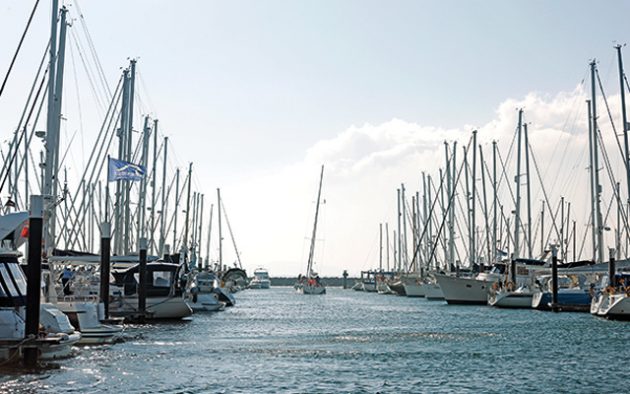Do you panic when trying to berth in a busy marina? How would you cope with strong cross wind? James Stevens answers your Questions of Seamanship
In a strong cross winds would you be able to berth safely in a busy marina?
James Stevens looks at the problem and provides the solution.
Question: Could you berth safely in a strong cross wind?
Andy and his wife Janet are reaching the end of a day’s sail to a favourite harbour on board Sea Thrift, a Bavaria 34 fin-keeled yacht.
The marina berth is booked, the sails are stowed, the fenders and warps ready.
On calling the marina on Channel 80 they are given berth A6.
As they approach they realise that booking was essential as it is the only visitor’s berth available.

Credit: Maxine Heath
The wind is blowing inwards at 10 to 15 knots between the pontoons A and B, so they will be berthing alongside A6, a finger pontoon.
On A7, the next berth outwards, is a yacht whose stern is sticking out into the channel, making the gap between A and B pontoons even narrower than normal.
On finger berth A5, to leeward of A6, is a smaller yacht, a classic, immaculately varnished, with its proud owner enjoying a drink in the cockpit.
Andy realises that when he turns around the stern of the large yacht and slows down, the wind is going to blow him onto the yacht on A5, whose owner doesn’t look the sort to tolerate poor boat handling.
How should Andy motor alongside his berth?
James Stevens answers:
If Andy tries to turn to port around the stern of the large yacht, Sea Thrift is likely to rest against the small classic yacht to leeward.
With only one crew, attaching lines on the dock quick enough to stop the yacht drifting sideways is almost impossible.
Normally, the yacht to leeward understands this and is well fendered, expecting the incoming yacht to be suitably prepared also.
On the other hand, it is not ideal to have a quiet evening drink in the cockpit interrupted by a boat drifting sideways into the topsides.
A better plan is for Andy to turn the yacht in the space outside the pontoons and motor astern between A and B pontoons.
Continues below…
Could you moor in a box berth under sail?
With an onshore wind and little space to manoeuvre, how would you tackle getting into a tight box berth? James…
Can you get the MOB back on the boat?
The RYA's former Yachtmaster chief examiner, James Stevens answers your questions of seamanship. This month, how would you deal with…
In a crowded anchorage, would you re-anchor?
The RYA's former Yachtmaster chief examiner, James Stevens answers your questions of seamanship. This month, how would you cope with…
Fenders are prepared on both sides and fore and aft lines set on the port side, along with a mid cleat line.

James Stevens, author of the Yachtmaster Handbook, spent 10 of his 23 years at the RYA as Training Manager and Yachtmaster Chief Examiner
He should keep over towards B pontoon, looking around to make sure the bow is not blown off towards any moored yachts.
On the way down he should note the position of the cleats on the pontoon.
When the stern is half-a-boat length or so from the shore, he should engage ahead and motor towards the berth.
The job is a lot easier if the prop kicks towards the pontoon.
Janet should stand near the shrouds, ready to step ashore quickly with the centre line and the bow line as well.
As soon as the yacht has stopped, Andy secures the stern line.
The manoeuvre is easier if there is a cleat for the centre line halfway down the finger pontoon so the yacht can be snubbed in tight while the other lines are attached.
Simple marina manoeuvres can be complicated by strong wind or tide.
Getting into a tight spot requires patience, and practice, and familiarity with your boat







